River Thames
 From Wikipedia the free encyclopedia
From Wikipedia the free encyclopedia
| River Thames | |
|---|---|
 | |
 Map of the Thames within southern England | |
| Etymology | Proto-Celtic *tamēssa, possibly meaning "dark" |
| Location | |
| Country | England |
| Counties | Gloucestershire, Wiltshire, Oxfordshire, Berkshire, Buckinghamshire, Surrey, Greater London, Kent, Essex |
| Towns/cities | Cricklade, Lechlade, Oxford, Abingdon, Wallingford, Reading, Henley-on-Thames, Marlow, Maidenhead, Windsor, Staines-upon-Thames, Walton-on-Thames, Sunbury-on-Thames, Kingston upon Thames, London (inc. Twickenham, the City), Dagenham, Erith, Dartford, Grays, Gravesend |
| Physical characteristics | |
| Source | |
| • location | Thames Head, Gloucestershire, UK |
| • coordinates | 51°41′40″N 02°01′47″W / 51.69444°N 2.02972°W |
| • elevation | 110 m (360 ft) |
| 2nd source | |
| • location | Ullenwood, Gloucestershire, UK |
| • coordinates | 51°50′49″N 02°04′41″W / 51.84694°N 2.07806°W |
| • elevation | 214 m (702 ft) |
| Mouth | Thames Estuary, North Sea |
• location | Southend-on-Sea, Essex, UK |
• coordinates | 51°30′00″N 00°36′36″E / 51.50000°N 0.61000°E |
• elevation | 0 m (0 ft) |
| Length | 346 km (215 mi) |
| Basin size | 12,935 km2 (4,994 sq mi) |
| Discharge | |
| • location | London |
| • average | 65.8 m3/s (2,320 cu ft/s) |
| • maximum | 370 m3/s (13,000 cu ft/s) |
| Discharge | |
| • location | entering Oxford |
| • average | 17.6 m3/s (620 cu ft/s) |
| Discharge | |
| • location | leaving Oxford |
| • average | 24.8 m3/s (880 cu ft/s) |
| Discharge | |
| • location | Reading, Berkshire |
| • average | 39.7 m3/s (1,400 cu ft/s) |
| Discharge | |
| • location | Windsor |
| • average | 59.3 m3/s (2,090 cu ft/s) |
Thameside settlements Towns/villages by parish beside the river blank spaces indicate as place above (") | |||||||||||||||||||||||||||||||||||||||||||||||||||||||||||||||||||||||||||||||||||||||||||||||||||||||||||||||||||||||||||||||||||||||||||||||||||||||||||||||||||||||||||||||||||||||||||||||||||||||||||||||||||||||||||||||||||||||||||||||||||||||||||||||||||||||||||||||||||||||||||||||||||||||||||||||||||||||||||||||||||||||||||||||||||||||||||||||||||||||||||||||||||||||||||||||||||||||||||||||||||||||||||||||||||||||||||||||||||||||||||||||||||||||||||||||||||||||||||||||||||||||||||||||||||||||||||||||||||||||||||||||||||||||||||||||||||||||||||||||||||||||||||||||||||||||||||||||||||||||||||||||||||||||||||||||||||||||||||||||||||||||||||||||||||||||||||||||||||||||||||||||||||||||||||||||||||||||||||||||||||||||||||||||||||||||||||||||||||||||||||||||||||||||||||||||||||||||||||||||||||||||||||||||||||||||||||||||||||||||||||||||||||||||||||||||||||||||||||||||||||||||||||||||||||||||||||||||||||||||||||||||||||||||||||||||||||||||||||||||||||||||||||||||||||||||||||||||||||||||
|---|---|---|---|---|---|---|---|---|---|---|---|---|---|---|---|---|---|---|---|---|---|---|---|---|---|---|---|---|---|---|---|---|---|---|---|---|---|---|---|---|---|---|---|---|---|---|---|---|---|---|---|---|---|---|---|---|---|---|---|---|---|---|---|---|---|---|---|---|---|---|---|---|---|---|---|---|---|---|---|---|---|---|---|---|---|---|---|---|---|---|---|---|---|---|---|---|---|---|---|---|---|---|---|---|---|---|---|---|---|---|---|---|---|---|---|---|---|---|---|---|---|---|---|---|---|---|---|---|---|---|---|---|---|---|---|---|---|---|---|---|---|---|---|---|---|---|---|---|---|---|---|---|---|---|---|---|---|---|---|---|---|---|---|---|---|---|---|---|---|---|---|---|---|---|---|---|---|---|---|---|---|---|---|---|---|---|---|---|---|---|---|---|---|---|---|---|---|---|---|---|---|---|---|---|---|---|---|---|---|---|---|---|---|---|---|---|---|---|---|---|---|---|---|---|---|---|---|---|---|---|---|---|---|---|---|---|---|---|---|---|---|---|---|---|---|---|---|---|---|---|---|---|---|---|---|---|---|---|---|---|---|---|---|---|---|---|---|---|---|---|---|---|---|---|---|---|---|---|---|---|---|---|---|---|---|---|---|---|---|---|---|---|---|---|---|---|---|---|---|---|---|---|---|---|---|---|---|---|---|---|---|---|---|---|---|---|---|---|---|---|---|---|---|---|---|---|---|---|---|---|---|---|---|---|---|---|---|---|---|---|---|---|---|---|---|---|---|---|---|---|---|---|---|---|---|---|---|---|---|---|---|---|---|---|---|---|---|---|---|---|---|---|---|---|---|---|---|---|---|---|---|---|---|---|---|---|---|---|---|---|---|---|---|---|---|---|---|---|---|---|---|---|---|---|---|---|---|---|---|---|---|---|---|---|---|---|---|---|---|---|---|---|---|---|---|---|---|---|---|---|---|---|---|---|---|---|---|---|---|---|---|---|---|---|---|---|---|---|---|---|---|---|---|---|---|---|---|---|---|---|---|---|---|---|---|---|---|---|---|---|---|---|---|---|---|---|---|---|---|---|---|---|---|---|---|---|---|---|---|---|---|---|---|---|---|---|---|---|---|---|---|---|---|---|---|---|---|---|---|---|---|---|---|---|---|---|---|---|---|---|---|---|---|---|---|---|---|---|---|---|---|---|---|---|---|---|---|---|---|---|---|---|---|---|---|---|---|---|---|---|---|---|---|---|---|---|---|---|---|---|---|---|---|---|---|---|---|---|---|---|---|---|---|---|---|---|---|---|---|---|---|---|---|---|---|---|---|---|---|---|---|---|---|---|---|---|---|---|---|---|---|---|---|---|---|---|---|---|---|---|---|---|---|---|---|---|---|---|---|---|---|---|---|---|---|---|---|---|---|---|---|---|---|---|---|---|---|---|---|---|---|---|---|---|---|---|---|---|---|---|---|---|---|---|---|---|---|---|---|---|---|---|---|---|---|---|---|---|---|---|---|---|---|---|---|---|---|---|---|---|---|---|---|---|---|---|---|---|---|---|---|---|---|---|---|---|---|---|---|---|---|---|---|---|---|---|---|---|---|---|---|---|---|---|---|---|---|---|---|---|---|---|---|---|---|---|---|---|---|---|---|---|---|---|---|---|---|---|---|---|---|---|---|---|---|---|---|---|---|---|---|---|---|---|---|---|---|---|---|---|---|---|---|---|---|---|---|---|---|---|---|---|---|---|---|---|---|---|---|---|---|---|---|---|---|---|---|---|---|---|---|---|---|---|---|---|---|---|---|---|---|---|---|---|---|---|---|---|---|---|---|---|---|---|---|---|---|---|---|---|---|---|---|---|---|---|---|---|---|---|---|---|---|---|---|---|---|---|---|---|---|---|---|---|---|---|---|---|---|---|---|---|---|---|---|---|---|---|---|---|---|---|---|---|---|---|---|---|---|---|---|---|---|---|---|---|---|---|---|---|---|---|---|---|---|---|---|---|---|---|---|---|---|---|---|---|---|---|---|---|---|---|---|---|---|---|---|---|---|---|---|---|---|---|---|---|---|---|---|---|---|---|---|---|---|---|---|---|---|---|---|---|---|---|---|---|---|---|---|---|---|---|---|---|---|---|---|---|---|---|---|---|---|---|---|---|---|---|---|---|---|---|---|---|---|---|---|---|---|---|---|---|---|---|---|---|---|---|---|---|---|---|---|---|---|---|---|---|---|---|---|---|---|---|---|---|---|---|---|
| |||||||||||||||||||||||||||||||||||||||||||||||||||||||||||||||||||||||||||||||||||||||||||||||||||||||||||||||||||||||||||||||||||||||||||||||||||||||||||||||||||||||||||||||||||||||||||||||||||||||||||||||||||||||||||||||||||||||||||||||||||||||||||||||||||||||||||||||||||||||||||||||||||||||||||||||||||||||||||||||||||||||||||||||||||||||||||||||||||||||||||||||||||||||||||||||||||||||||||||||||||||||||||||||||||||||||||||||||||||||||||||||||||||||||||||||||||||||||||||||||||||||||||||||||||||||||||||||||||||||||||||||||||||||||||||||||||||||||||||||||||||||||||||||||||||||||||||||||||||||||||||||||||||||||||||||||||||||||||||||||||||||||||||||||||||||||||||||||||||||||||||||||||||||||||||||||||||||||||||||||||||||||||||||||||||||||||||||||||||||||||||||||||||||||||||||||||||||||||||||||||||||||||||||||||||||||||||||||||||||||||||||||||||||||||||||||||||||||||||||||||||||||||||||||||||||||||||||||||||||||||||||||||||||||||||||||||||||||||||||||||||||||||||||||||||||||||||||||||||||
Thames bridges | |||||||||||||||||||||||||||||||||||||||||||||||||||||||||||||||||||||||||||||||||||||||||||||||||||||||||||||||||||||||||||||||||||||||||||||||||||||||||||||||||||||||||||||||||||||||||||||||||||||||||||||||||||||||||||||||||||||||||||||||||||||||||||||||||||||||||||||||||||||||||||||||||||||||||||||||||||||||||||||||||||||||||||||||||||||||||||||||||||||||||||||||||||||||||||||||||||||||||||||||||||||||||||||||||||||||||||||||||||||||||||||||||||||||||||||||||||||||||||||||||||||||||||||||||||||||||||||||||||||||||||||||||||||||||||||||||||||||||||||||||||||||||||||||||||||||||||||||||||||||||||||||||||||||||||||||||||||||||||||||||||||||||||||||||||||||||||||||||||||||||||||||||||||||||||||||||||||||||||||||||||||||||||||||||||||||||||||||||||||||||||||||||||||||||||||||||||||||||||||||||||||||||||||||||||||||||||||||||||||||||||||||||||||||||||||||||||||||||||||||||||||||||||||||||||||||||||||||||||||||||||||||||||||||||||||||||||||||||||||||||||||||||||||||||||||||||||||||||||||||
|---|---|---|---|---|---|---|---|---|---|---|---|---|---|---|---|---|---|---|---|---|---|---|---|---|---|---|---|---|---|---|---|---|---|---|---|---|---|---|---|---|---|---|---|---|---|---|---|---|---|---|---|---|---|---|---|---|---|---|---|---|---|---|---|---|---|---|---|---|---|---|---|---|---|---|---|---|---|---|---|---|---|---|---|---|---|---|---|---|---|---|---|---|---|---|---|---|---|---|---|---|---|---|---|---|---|---|---|---|---|---|---|---|---|---|---|---|---|---|---|---|---|---|---|---|---|---|---|---|---|---|---|---|---|---|---|---|---|---|---|---|---|---|---|---|---|---|---|---|---|---|---|---|---|---|---|---|---|---|---|---|---|---|---|---|---|---|---|---|---|---|---|---|---|---|---|---|---|---|---|---|---|---|---|---|---|---|---|---|---|---|---|---|---|---|---|---|---|---|---|---|---|---|---|---|---|---|---|---|---|---|---|---|---|---|---|---|---|---|---|---|---|---|---|---|---|---|---|---|---|---|---|---|---|---|---|---|---|---|---|---|---|---|---|---|---|---|---|---|---|---|---|---|---|---|---|---|---|---|---|---|---|---|---|---|---|---|---|---|---|---|---|---|---|---|---|---|---|---|---|---|---|---|---|---|---|---|---|---|---|---|---|---|---|---|---|---|---|---|---|---|---|---|---|---|---|---|---|---|---|---|---|---|---|---|---|---|---|---|---|---|---|---|---|---|---|---|---|---|---|---|---|---|---|---|---|---|---|---|---|---|---|---|---|---|---|---|---|---|---|---|---|---|---|---|---|---|---|---|---|---|---|---|---|---|---|---|---|---|---|---|---|---|---|---|---|---|---|---|---|---|---|---|---|---|---|---|---|---|---|---|---|---|---|---|---|---|---|---|---|---|---|---|---|---|---|---|---|---|---|---|---|---|---|---|---|---|---|---|---|---|---|---|---|---|---|---|---|---|---|---|---|---|---|---|---|---|---|---|---|---|---|---|---|---|---|---|---|---|---|---|---|---|---|---|---|---|---|---|---|---|---|---|---|---|---|---|---|---|---|---|---|---|---|---|---|---|---|---|---|---|---|---|---|---|---|---|---|---|---|---|---|---|---|---|---|---|---|---|---|---|---|---|---|---|---|---|---|---|---|---|---|---|---|---|---|---|---|---|---|---|---|---|---|---|---|---|---|---|---|---|---|---|---|---|---|---|---|---|---|---|---|---|---|---|---|---|---|---|---|---|---|---|---|---|---|---|---|---|---|---|---|---|---|---|---|---|---|---|---|---|---|---|---|---|---|---|---|---|---|---|---|---|---|---|---|---|---|---|---|---|---|---|---|---|---|---|---|---|---|---|---|---|---|---|---|---|---|---|---|---|---|---|---|---|---|---|---|---|---|---|---|---|---|---|---|---|---|---|---|---|---|---|---|---|---|---|---|---|---|---|---|---|---|---|---|---|---|---|---|---|---|---|---|---|---|---|---|---|---|---|---|---|---|---|---|---|---|---|---|---|---|---|---|---|---|---|---|---|---|---|---|---|---|---|---|---|---|---|---|---|---|---|---|---|---|---|---|---|---|---|---|---|---|---|---|---|---|---|---|---|---|---|---|---|---|---|---|---|---|---|---|---|---|---|---|---|---|---|---|---|---|---|---|---|---|---|---|---|---|---|---|---|---|---|---|---|---|---|---|---|---|---|---|---|---|---|---|---|---|---|---|---|---|---|---|---|---|---|---|---|---|---|---|---|---|---|---|---|---|---|---|---|---|---|---|---|---|---|---|---|---|---|---|---|---|---|---|---|---|---|---|---|---|---|---|---|---|---|---|---|---|---|---|---|---|---|---|---|---|---|---|---|---|---|---|---|---|---|---|---|---|---|---|---|---|---|---|---|---|---|---|---|---|---|---|---|---|---|---|---|---|---|---|---|---|---|---|---|---|---|---|---|---|---|---|---|---|---|---|---|---|---|---|---|---|---|---|---|---|---|---|---|---|---|---|---|---|---|---|---|---|---|---|---|---|---|---|---|---|---|---|---|---|---|---|---|---|---|---|---|---|---|---|---|---|---|---|---|---|---|---|---|---|---|---|---|---|---|---|---|---|---|---|---|---|---|---|---|---|---|---|---|---|---|---|---|---|---|---|---|---|---|---|---|---|---|---|---|---|---|---|---|---|---|---|---|---|---|---|---|---|---|---|---|---|---|---|---|---|---|---|---|---|---|---|---|---|---|---|---|---|---|---|---|---|---|---|---|---|
| |||||||||||||||||||||||||||||||||||||||||||||||||||||||||||||||||||||||||||||||||||||||||||||||||||||||||||||||||||||||||||||||||||||||||||||||||||||||||||||||||||||||||||||||||||||||||||||||||||||||||||||||||||||||||||||||||||||||||||||||||||||||||||||||||||||||||||||||||||||||||||||||||||||||||||||||||||||||||||||||||||||||||||||||||||||||||||||||||||||||||||||||||||||||||||||||||||||||||||||||||||||||||||||||||||||||||||||||||||||||||||||||||||||||||||||||||||||||||||||||||||||||||||||||||||||||||||||||||||||||||||||||||||||||||||||||||||||||||||||||||||||||||||||||||||||||||||||||||||||||||||||||||||||||||||||||||||||||||||||||||||||||||||||||||||||||||||||||||||||||||||||||||||||||||||||||||||||||||||||||||||||||||||||||||||||||||||||||||||||||||||||||||||||||||||||||||||||||||||||||||||||||||||||||||||||||||||||||||||||||||||||||||||||||||||||||||||||||||||||||||||||||||||||||||||||||||||||||||||||||||||||||||||||||||||||||||||||||||||||||||||||||||||||||||||||||||||||||||||||||
The River Thames (/tɛmz/ ⓘ TEMZ), known alternatively in parts as the River Isis, is a river that flows through southern England including London. At 215 miles (346 km), it is the longest river entirely in England and the second-longest in the United Kingdom, after the River Severn.
The river rises at Thames Head in Gloucestershire and flows into the North Sea near Tilbury, Essex and Gravesend, Kent, via the Thames Estuary. From the west, it flows through Oxford (where it is sometimes called the Isis), Reading, Henley-on-Thames and Windsor. The Thames also drains the whole of Greater London.[1]
The lower reaches of the river are called the Tideway, derived from its long tidal reach up to Teddington Lock. Its tidal section includes most of its London stretch and has a rise and fall of 23 ft (7 m). From Oxford to the estuary, the Thames drops by 55 metres (180 ft). Running through some of the drier parts of mainland Britain and heavily abstracted for drinking water, the Thames' discharge is low considering its length and breadth: the Severn has a discharge almost twice as large on average despite having a smaller drainage basin. In Scotland, the Tay achieves more than double the Thames' average discharge from a drainage basin that is 60% smaller.
Along its course are 45 navigation locks with accompanying weirs. Its catchment area covers a large part of south-eastern and a small part of western England; the river is fed by at least 50 named tributaries. The river contains over 80 islands. With its waters varying from freshwater to almost seawater, the Thames supports a variety of wildlife and has a number of adjoining Sites of Special Scientific Interest, with the largest being in the North Kent Marshes and covering 20.4 sq mi (5,289 ha).[2]
Name[edit]
Brittonic origin[edit]

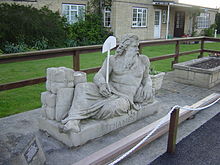
According to Mallory and Adams, the Thames, from Middle English Temese, is derived from the Brittonic name for the river, Tamesas (from *tamēssa),[3] recorded in Latin as Tamesis and yielding modern Welsh Tafwys "Thames".
The name element Tam may have meant "dark" and can be compared to other cognates such as Russian темно (Proto-Slavic *tĭmĭnŭ), Lithuanian tamsi "dark", Latvian tumsa "darkness", Sanskrit tamas and Welsh tywyll "darkness" and Middle Irish teimen "dark grey".[3][b] The origin is shared by many other river names in Britain, such as the River Tamar at the border of Devon and Cornwall, several rivers named Tame in the Midlands and North Yorkshire, the Tavy on Dartmoor, the Team of the North East, the Teifi and Teme of Wales, the Teviot in the Scottish Borders and a Thames tributary the Thame.
Kenneth H. Jackson proposed that the name of the Thames is not Indo-European (and of unknown meaning),[5] while Peter Kitson suggested that it is Indo-European but originated before the Britons and has a name indicating "muddiness" from a root *tā-, 'melt'.[6]
Name history[edit]
Early variants of the name include:
- Tamesa (Brittonic)[4]
- Tamesis (Latin)[4]
- Tamis, Temes (Old English)[4]
- Tamise, Thamis (1220) (Middle English, Anglo-Norman French)[c]
Indirect evidence for the antiquity of the name "Thames" is provided by a Roman potsherd found at Oxford, bearing the inscription Tamesubugus fecit (Tamesubugus made [this]). It is believed that Tamesubugus' name was derived from that of the river.[7] Tamese was referred to as a place, not a river in the Ravenna Cosmography (c. AD 700).
The river's name has always been pronounced with a simple t /t/; the Middle English spelling was typically Temese and the Brittonic form Tamesis. A similar spelling from 1210, "Tamisiam" (the accusative case of "Tamisia"; see Kingston upon Thames § Early history), is found in Magna Carta.[8]

The Isis[edit]
The Thames through Oxford is sometimes[when?] called the Isis. Historically, and especially in Victorian times, gazetteers and cartographers insisted that the entire river was correctly named the Isis from its source down to Dorchester on Thames and that only from this point, where the river meets the Thame and becomes the "Thame-isis" (supposedly subsequently abbreviated to Thames) should it be so called.[citation needed] Ordnance Survey maps still label the Thames as "River Thames or Isis" down to Dorchester. Since the early 20th century this distinction has been lost in common usage outside of Oxford, and some historians [who?] suggest the name Isis is nothing more than a truncation of Tamesis, the Latin name for the Thames. Sculptures titled Tamesis and Isis by Anne Seymour Damer are located on the bridge at Henley-on-Thames, Oxfordshire (the original terracotta and plaster models were exhibited at the Royal Academy, London, in 1785. They are now[when?] on show at the River and Rowing Museum in Henley).[9]
Name legacy[edit]
Richard Coates suggests that while the river was as a whole called the Thames, part of it, where it was too wide to ford, was called *(p)lowonida. This gave the name to a settlement on its banks, which became known as Londinium, from the Indo-European roots *pleu- "flow" and *-nedi "river" meaning something like the flowing river or the wide flowing unfordable river.[10][11]
The river gives its name to three informal areas: the Thames Valley, a region of England around the river between Oxford and West London; the Thames Gateway; and the greatly overlapping Thames Estuary around the tidal Thames to the east of London and including the waterway itself. Thames Valley Police is a formal body that takes its name from the river, covering three counties. In non-administrative use, the river's name is used in those of Thames Valley University, Thames Water, Thames Television, publishing company Thames & Hudson, Thameslink (north–south rail service passing through central London) and South Thames College. An example of its use in the names of historic entities is the Thames Ironworks and Shipbuilding Company.
History[edit]
Marks of human activity, in some cases dating back to Pre-Roman Britain, are visible at various points along the river. These include a variety of structures connected with use of the river, such as navigations, bridges and watermills, as well as prehistoric burial mounds.
The lower Thames in the Roman era was a shallow waterway winding through marshes. But centuries of human intervention have transformed it into a deep tidal canal flowing between 200 miles of solid walls; these defend a floodplain where 1.5 million people work and live.
A major maritime route is formed for much of its length for shipping and supplies: through the Port of London for international trade, internally along its length and by its connection to the British canal system. The river's position has put it at the centre of many events in British history, leading to it being described by John Burns as "liquid history".
Two broad canals link the river to other rivers: the Kennet and Avon Canal (Reading to Bath) and the Grand Union Canal (London to the Midlands). The Grand Union effectively bypassed the earlier, narrow and winding Oxford Canal which remains open as a popular scenic recreational route. Three further cross-basin canals are disused but are in various stages of reconstruction: the Thames and Severn Canal (via Stroud), which operated until 1927 (to the west coast of England), the Wey and Arun Canal to Littlehampton, which operated until 1871 (to the south coast), and the Wilts & Berks Canal.
Rowing and sailing clubs are common along the Thames, which is navigable to such vessels. Kayaking and canoeing also take place. Major annual events include the Henley Royal Regatta and the Boat Race, while the Thames has been used during two Summer Olympic Games: 1908 (rowing) and 1948 (rowing and canoeing). Safe headwaters and reaches are a summer venue for organised swimming, which is prohibited on safety grounds in a stretch centred on Central London.
Conversion of marshland[edit]
After the river took its present-day course, many of the banks of the Thames Estuary and the Thames Valley in London were partly covered in marshland, as was the adjoining Lower Lea Valley. Streams and rivers like the River Lea, Tyburn Brook and Bollo Brook drained into the river, while some islands, e.g. Thorney Island, formed over the ages. The northern tip of the ancient parish of Lambeth, for example, was marshland known as Lambeth Marshe, but it was drained in the 18th century; the street name Lower Marsh preserves a memory.[12]
Until the middle of the Victorian era, malaria was commonplace beside the River Thames, even in London, and was frequently lethal. Some cases continued to occur into the early 20th century. Draining of the marshes had to do with its eradication, but the causes are complex and unclear.
The East End of London, also known simply as the East End, was the area of London east of the medieval walled City of London and north of the River Thames, although it is not defined by universally accepted formal boundaries; the River Lea can be considered another boundary.[13] Most of the local riverside was also marshland. The land was drained and became farmland; it was built on after the Industrial Revolution.
Canvey Island in southern Essex (area 18.45 km2, 7.12 sq mi; population 40,000[14]) was once marshy, but is now a fully reclaimed island in the Thames estuary, separated from the mainland of south Essex by a network of creeks. Lying below sea level, it is prone to flooding at exceptional tides, but has nevertheless been inhabited since Roman times.
Course[edit]
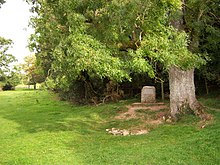

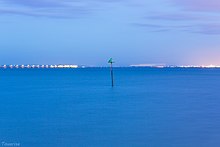
The usually quoted source of the Thames is at Thames Head (at grid reference ST980994). This is about 3⁄4 mi (1.2 km)[15] north of Kemble parish church in southern Gloucestershire, near the town of Cirencester, in the Cotswolds.[16] However, Seven Springs near Cheltenham, where the Churn (which feeds into the Thames near Cricklade) rises, is also sometimes quoted as the Thames' source,[17][18] as this location is farthest from the mouth and adds some 14 mi (23 km) to the river's length. At Seven Springs above the source is a stone with the Latin hexameter inscription "Hic tuus o Tamesine pater septemgeminus fons", which means "Here, O Father Thames, [is] your sevenfold source".[19]
The springs at Seven Springs flow throughout the year, while those at Thames Head are seasonal (a winterbourne). With a length of 215 mi (346 km),[20] the Thames is the longest river entirely in England. (The longest river in the United Kingdom, the Severn, flows partly in Wales.) However, as the River Churn, sourced at Seven Springs, is 14 mi (23 km) longer than the section of the Thames from its traditional source at Thames Head to the confluence, the overall length of the Thames measured from Seven Springs, at 229 mi (369 km), is greater than the Severn's length of 220 mi (350 km).[21] Thus, the "Churn/Thames" river may be regarded as the longest natural river in the United Kingdom. The stream from Seven Springs is joined at Coberley by a longer tributary which could further increase the length of the Thames, with its source in the grounds of the National Star College at Ullenwood.
The Thames flows through or alongside Ashton Keynes, Cricklade, Lechlade, Oxford, Abingdon-on-Thames, Wallingford, Goring-on-Thames and Streatley (at the Goring Gap), Pangbourne and Whitchurch-on-Thames, Reading, Wargrave, Henley-on-Thames, Marlow, Maidenhead, Windsor and Eton, Staines-upon-Thames and Egham, Chertsey, Shepperton, Weybridge, Sunbury-on-Thames, Walton-on-Thames, Molesey and Thames Ditton. The river was subject to minor redefining and widening of the main channel around Oxford, Abingdon and Marlow before 1850, when further cuts to ease navigation reduced distances further.
Molesey faces Hampton, and in Greater London the Thames passes Hampton Court Palace, Surbiton, Kingston upon Thames, Teddington, Twickenham, Richmond (with a famous view of the Thames from Richmond Hill), Syon House, Kew, Brentford, Chiswick, Barnes, Hammersmith, Fulham, Putney, Wandsworth, Battersea and Chelsea. In central London, the river passes Pimlico and Vauxhall, and then forms one of the principal axes of the city, from the Palace of Westminster to the Tower of London. At this point, it historically formed the southern boundary of the medieval city, with Southwark, on the opposite bank, then being part of Surrey.
Beyond central London, the river passes Bermondsey, Wapping, Shadwell, Limehouse, Rotherhithe, Millwall, Deptford, Greenwich, Cubitt Town, Blackwall, New Charlton and Silvertown, before flowing through the Thames Barrier, which protects central London from flooding by storm surges. Below the barrier, the river passes Woolwich, Thamesmead, Dagenham, Erith, Purfleet, Dartford, West Thurrock, Northfleet, Tilbury and Gravesend before entering the Thames Estuary near Southend-on-Sea.
Sea level[edit]
The sea level in the Thames estuary is rising and the rate of rise is increasing.[22][23]
Sediment cores up to 10 m deep collected by the British Geological Survey from the banks of the tidal River Thames contain geochemical information and fossils which provide a 10,000-year record of sea-level change.[24] Combined, this and other studies suggest that the Thames sea-level has risen more than 30 m during the Holocene at a rate of around 5–6 mm per year from 10,000 to 6,000 years ago.[24] The rise of sea level dramatically reduced when the ice melt nearly concluded[clarification needed] over the past 4,000 years. Since the beginning of the 20th century, rates of sea level rise range from 1.22 mm per year to 2.14 mm per year.[24]
Catchment area and discharge[edit]
The Thames River Basin[25] District, including the Medway catchment, covers an area of 6,229 sq mi (16,130 km2).[26] The entire river basin is a mixture of urban and rural, with rural landscape predominating in the western part. The area is among the driest in the United Kingdom. Water resources consist of groundwater from aquifers and water taken from the Thames and its tributaries, much of it stored in large bank-side reservoirs.[26]
The Thames itself provides two-thirds of London's drinking water, while groundwater supplies about 40 per cent of public water supplies in the overall catchment area. Groundwater is an important water source, especially in the drier months, so maintaining its quality and quantity is extremely important. Groundwater is vulnerable to surface pollution, especially in highly urbanised areas.[26]
Non-tidal section[edit]



Brooks, canals and rivers, within an area of 3,842 sq mi (9,951 km2),[27] combine to form 38 main tributaries feeding the Thames between its source and Teddington Lock. This is the usual tidal limit; however, high spring tides can raise the head water level in the reach above Teddington and can occasionally reverse the river flow for a short time. In these circumstances, tidal effects can be observed upstream to the next lock beside Molesey weir,[27] which is visible from the towpath and bridge beside Hampton Court Palace. Before Teddington Lock was built in 1810–12, the river was tidal at peak spring tides as far as Staines upon Thames.
In descending order, non-related tributaries of the non-tidal Thames, with river status, are the Churn, Leach, Cole, Ray, Coln, Windrush, Evenlode, Cherwell, Ock, Thame, Pang, Kennet, Loddon, Colne, Wey and Mole. In addition, there are occasional backwaters and artificial cuts that form islands, distributaries (most numerous in the case of the Colne), and man-made distributaries such as the Longford River. Three canals intersect this stretch: the Oxford Canal, Kennet and Avon Canal and Wey Navigation.
Its longest artificial secondary channel (cut), the Jubilee River, was built between Maidenhead and Windsor for flood relief and completed in 2002.[28][29]
The non-tidal section of the river is managed by the Environment Agency, which is responsible for managing the flow of water to help prevent and mitigate flooding, and providing for navigation: the volume and speed of water downstream is managed by adjusting the sluices at each of the weirs and, at peak high water, levels are generally dissipated over preferred flood plains adjacent to the river. Occasionally, flooding of inhabited areas is unavoidable and the agency issues flood warnings. Due to stiff penalties applicable on the non-tidal river, which is a drinking water source before treatment, sanitary sewer overflow from the many sewage treatment plants covering the upper Thames basin should be rare in the non-tidal Thames. However, storm sewage overflows are still common in almost all the main tributaries of the Thames[30][31] despite claims by Thames Water to the contrary.[32]
Tidal section[edit]
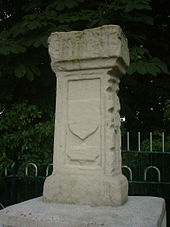

Below Teddington Lock (about 55 mi or 89 km upstream of the Thames Estuary), the river is subject to tidal activity from the North Sea. Before the lock was installed, the river was tidal as far as Staines, about 16 mi (26 km) upstream.[33] London, capital of Roman Britain, was established on two hills, now known as Cornhill and Ludgate Hill. These provided a firm base for a trading centre at the lowest possible point on the Thames.[34]
A river crossing was built at the site of London Bridge. London Bridge is now used as the basis for published tide tables giving the times of high tide. High tide reaches Putney about 30 minutes later than London Bridge, and Teddington about an hour later. The tidal stretch of the river is known as "the Tideway". Tide tables are published by the Port of London Authority and are available online. Times of high and low tides are also posted on Twitter.
The principal tributaries of the River Thames on the Tideway include the rivers Crane, Brent, Wandle, Ravensbourne (the final part of which is called Deptford Creek), Lea (the final part of which is called Bow Creek), Roding (Barking Creek), Darent and Ingrebourne. In London, the water is slightly brackish with sea salt, being a mix of sea and fresh water.
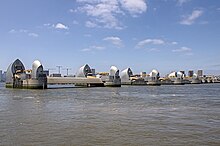
This part of the river is managed by the Port of London Authority. The flood threat here comes from high tides and strong winds from the North Sea, and the Thames Barrier was built in the 1980s to protect London from this risk.
The Nore is the sandbank that marks the mouth of the Thames Estuary, where the outflow from the Thames meets the North Sea. It is roughly halfway between Havengore Creek in Essex and Warden Point on the Isle of Sheppey in Kent. Until 1964 it marked the seaward limit of the Port of London Authority. As the sandbank was a major hazard for shipping coming in and out of London, in 1732 it received the world's first lightship. This became a major landmark, and was used as an assembly point for shipping. Today it is marked by Sea Reach No. 1 Buoy.[35]
Islands[edit]

The River Thames contains over 80 islands ranging from the large estuarial marshlands of the Isle of Sheppey and Canvey Island to small tree-covered islets like Rose Isle in Oxfordshire and Headpile Eyot in Berkshire. They are found all the way from Fiddler's Island in Oxfordshire to the Isle of Sheppey in Kent. Some of the largest inland islands, for example Formosa Island near Cookham and Andersey Island at Abingdon, were created naturally when the course of the river divided into separate streams.
In the Oxford area the river splits into several streams across the floodplain (Seacourt Stream, Castle Mill Stream, Bulstake Stream and others), creating several islands (Fiddler's Island, Osney and others). Desborough Island, Ham Island at Old Windsor and Penton Hook Island were artificially created by lock cuts and navigation channels. Chiswick Eyot is a landmark on the Boat Race course, while Glover's Island forms the centre of a view from Richmond Hill.
Islands of historical interest include Magna Carta Island at Runnymede, Fry's Island at Reading, and Pharaoh's Island near Shepperton. In more recent times Platts Eyot at Hampton was the place where Motor Torpedo Boats (MTB)s were built, Tagg's Island near Molesey was associated with the impresario Fred Karno and Eel Pie Island at Twickenham was the birthplace of the South East's R&B music scene.
Westminster Abbey and the Palace of Westminster (commonly known today as the Houses of Parliament) were built on Thorney Island, which used to be an eyot.
Geology[edit]
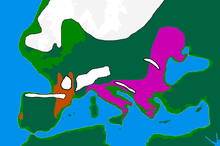
Researchers have identified the River Thames as a discrete drainage line flowing as early as 58 million years ago, in the Thanetian stage of the late Palaeocene epoch.[36] Until around 500,000 years ago, the Thames flowed on its existing course through what is now Oxfordshire, before turning to the north-east through Hertfordshire and East Anglia and reaching the North Sea near present-day Ipswich.[37]
At this time the river-system headwaters lay in the English West Midlands and may, at times, have received drainage from the Berwyn Mountains in North Wales.
Ice age[edit]
About 450,000 years ago, in the most extreme Ice Age of the Pleistocene, the Anglian, the furthest southern extent of the ice sheet reached Hornchurch[38] in east London, the Vale of St Albans, and the Finchley Gap.
It dammed the river in Hertfordshire, resulting in the formation of large ice lakes, which eventually burst their banks and caused the river to divert onto its present course through the area of present-day London.
The ice lobe which stopped at present-day Finchley deposited about 14 metres of boulder clay there.[39] Its torrent of meltwater gushed through the Finchley Gap and south towards the new course of the Thames, and proceeded to carve out the Brent Valley in the process.[40]
The Anglian ice advance resulted in a new course for the Thames through Berkshire and on into London, after which the river rejoined its original course in southern Essex, near the present River Blackwater estuary. Here it entered a substantial freshwater lake in the southern North Sea basin, south of what is called Doggerland. The overspill of this lake caused the formation of the Channel River and later the Dover Strait gap between present-day Britain and France. Subsequent development led to the continuation of the course that the river follows at the present day.[41]
Most of the bedrock of the Vale of Aylesbury comprises clay and chalk that formed at the end of the ice age and at one time was under the Proto-Thames. At this time the vast underground reserves of water formed that make the water table higher than average in the Vale of Aylesbury.[42]


At the height of the last ice age, around 20,000 BC, Britain was connected to mainland Europe by a large expanse of land known as Doggerland in the southern North Sea Basin. At this time, the Thames' course did not continue to Doggerland but flowed southwards from the eastern Essex coast where it met the waters of the proto-